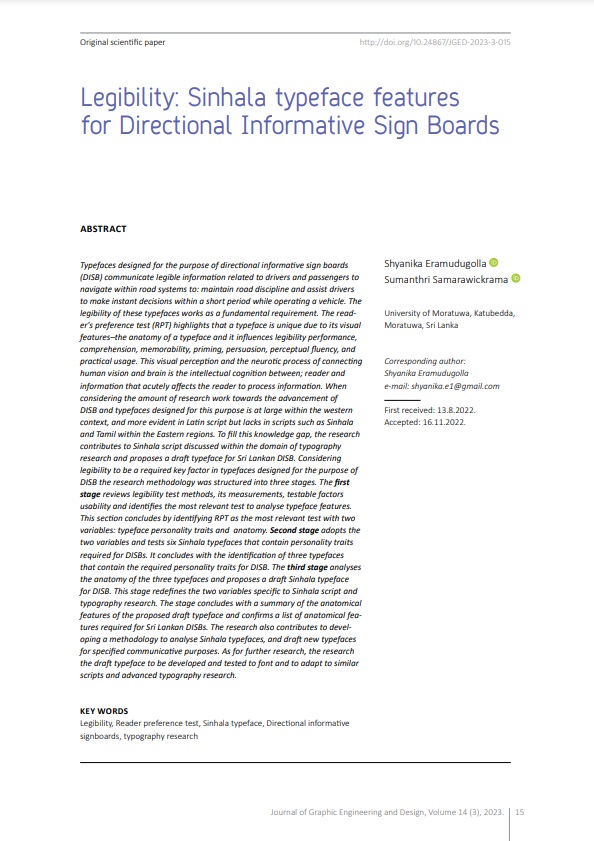Legibility: Sinhala typeface features for Directional Informative Sign Boards

Published 2023-09-01
abstract views: 92 // Full text article (PDF): 144
Keywords
- Legibility,
- Reader preference test,
- Sinhala typeface,
- Directional informative signboards,
- Typography research
How to Cite
Copyright (c) 2023 © 2023 Authors. Published by the University of Novi Sad, Faculty of Technical Sciences, Department of Graphic Engineering and Design. This article is an open access article distributed under the terms and conditions of the Creative Commons Attribution license 3.0 Serbia.

This work is licensed under a Creative Commons Attribution 3.0 Unported License.
Abstract
Typefaces designed for the purpose of directional informative sign boards (DISB) communicate legible information related to drivers and passengers to navigate within road systems to: maintain road discipline and assist drivers to make instant decisions within a short period while operating a vehicle. The legibility of these typefaces works as a fundamental requirement. The reader's preference test (RPT) highlights that a typeface is unique due to its visual features–the anatomy of a typeface and it influences legibility performance, comprehension, memorability, priming, persuasion, perceptual fluency, and practical usage. This visual perception and the neurotic process of connecting human vision and brain is the intellectual cognition between; reader and information that acutely affects the reader to process information. When considering the amount of research work towards the advancement of DISB and typefaces designed for this purpose is at large within the western context, and more evident in Latin script but lacks in scripts such as Sinhala and Tamil within the Eastern regions. To fill this knowledge gap, the research contributes to Sinhala script discussed within the domain of typography research and proposes a draft typeface for Sri Lankan DISB. Considering legibility to be a required key factor in typefaces designed for the purpose of DISB the research methodology was structured into three stages. The first stage reviews legibility test methods, its measurements, testable factors usability and identifies the most relevant test to analyse typeface features. This section concludes by identifying RPT as the most relevant test with two variables: typeface personality traits and anatomy. Second stage adopts the two variables and tests six Sinhala typefaces that contain personality traits required for DISBs. It concludes with the identification of three typefaces that contain the required personality traits for DISB. The third stage analyses the anatomy of the three typefaces and proposes a draft Sinhala typeface for DISB. This stage redefines the two variables specific to Sinhala script and typography research. The stage concludes with a summary of the anatomical features of the proposed draft typeface and confirms a list of anatomical features required for Sri Lankan DISBs. The research also contributes to developing a methodology to analyse Sinhala typefaces, and draft new typefaces for specified communicative purposes. As for further research, the research the draft typeface to be developed and tested to font and to adapt to similar scripts and advanced typography research.
Article history: Received (August 13, 2022); Revised (November 8, 2022); Accepted (November 16, 2022); Published online (September 1, 2023)

